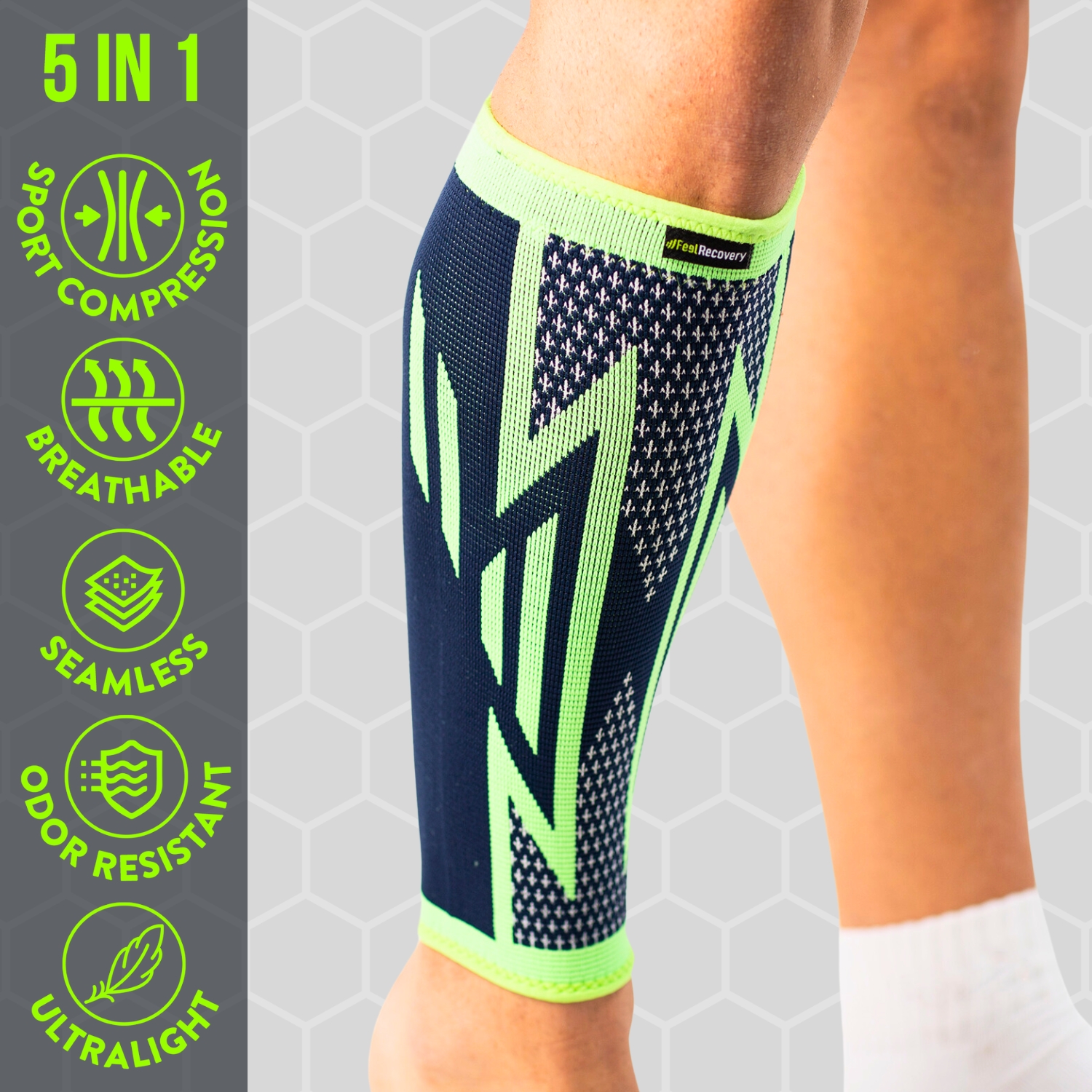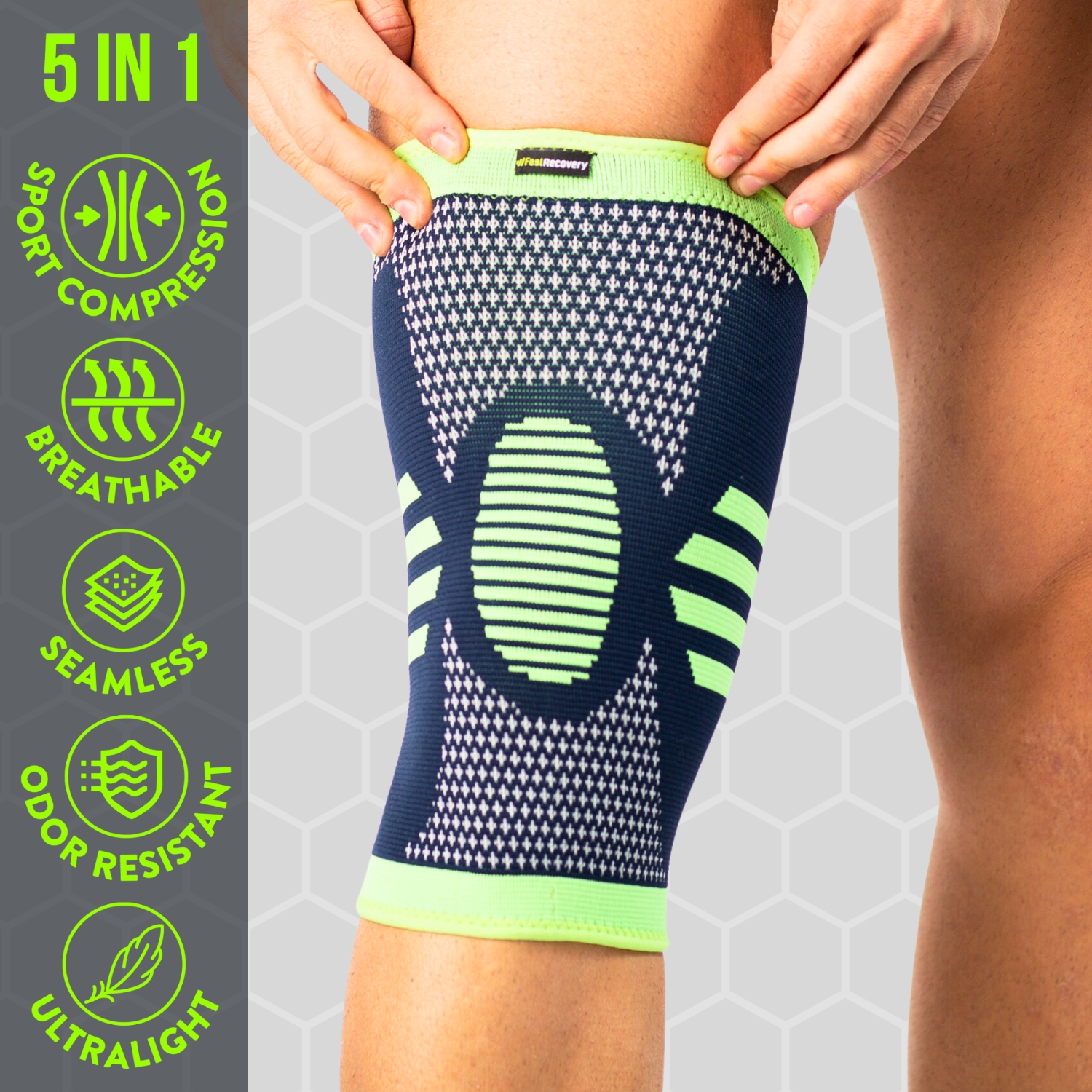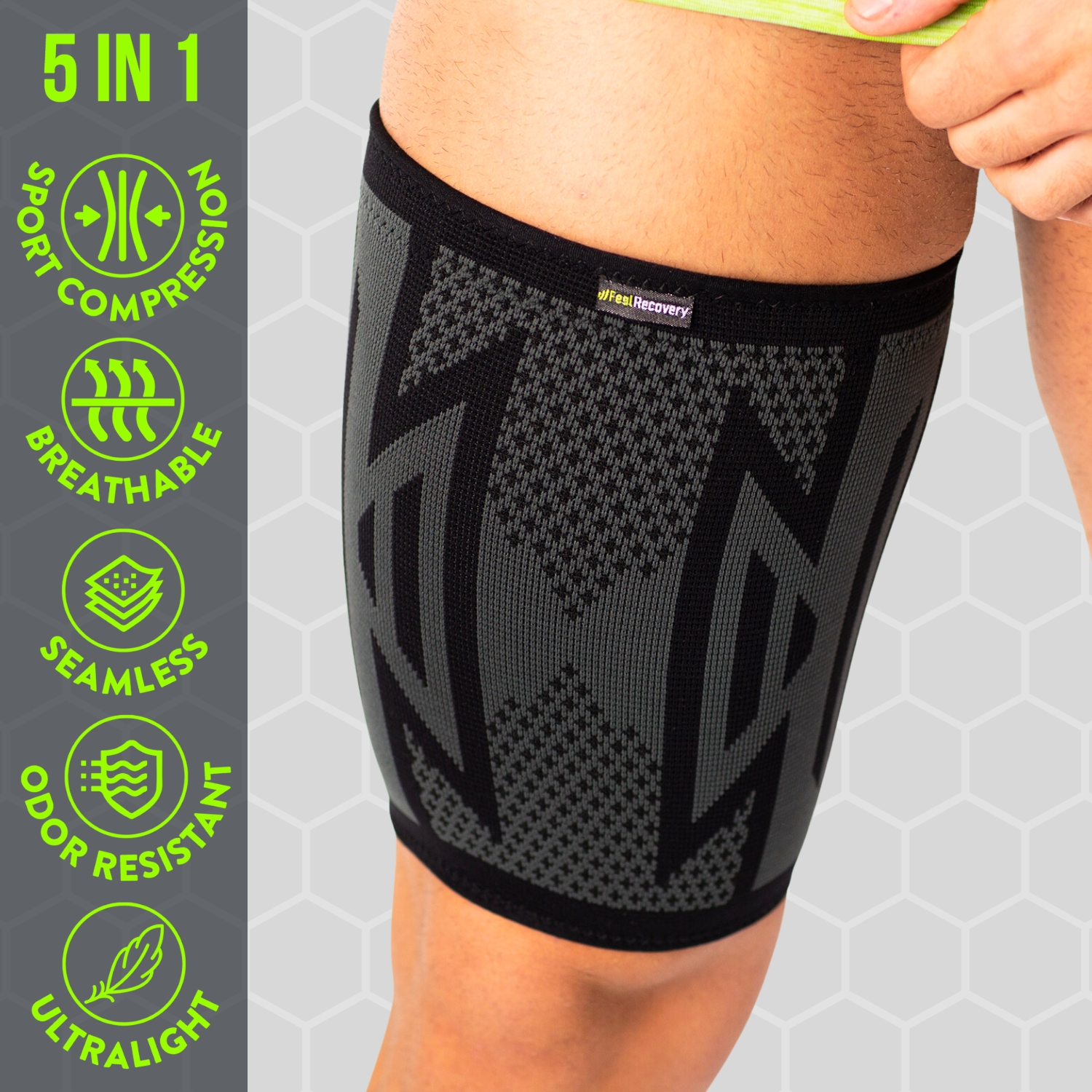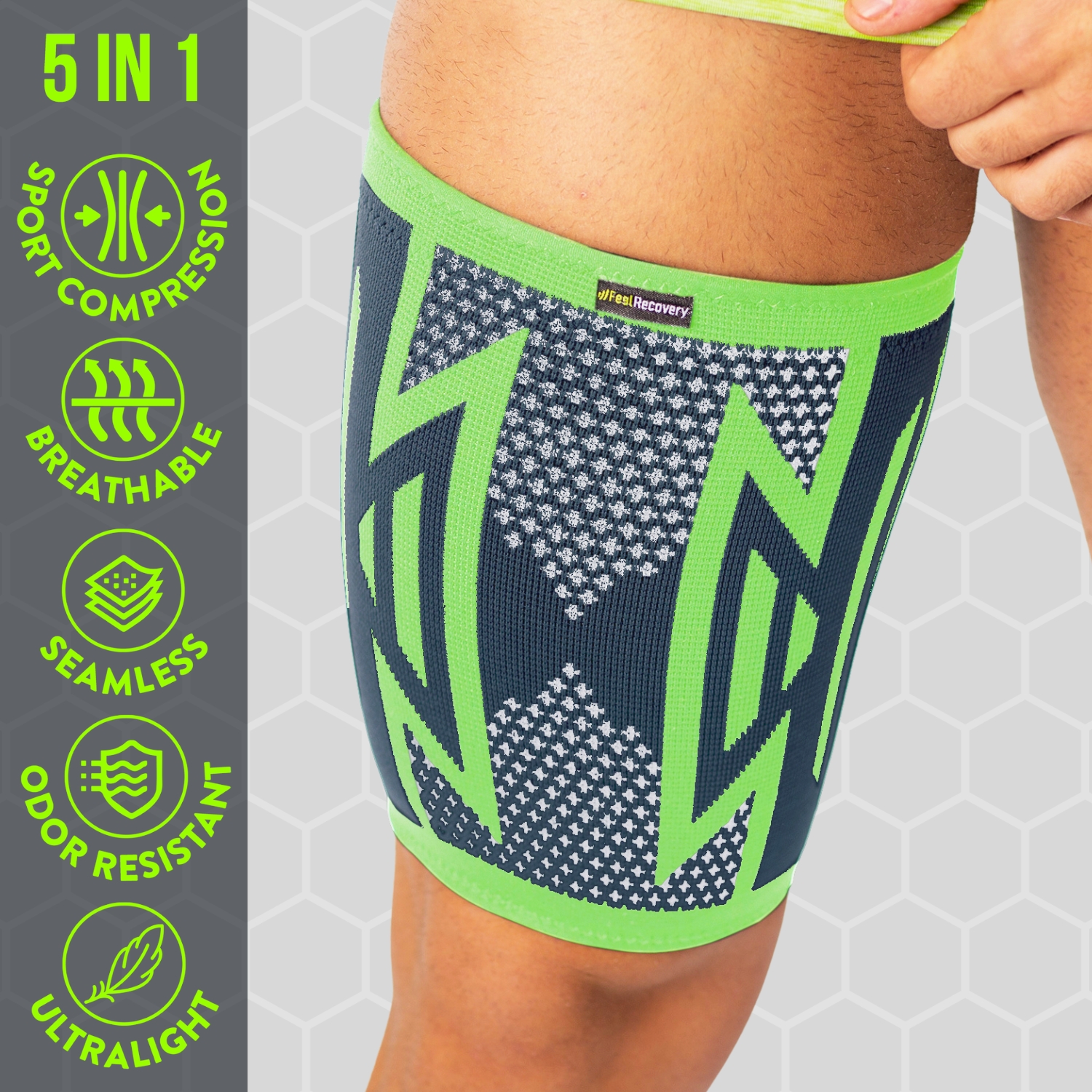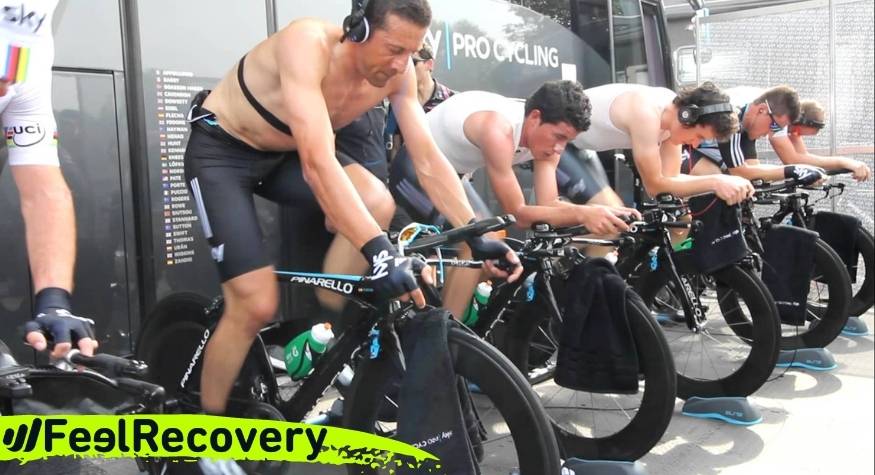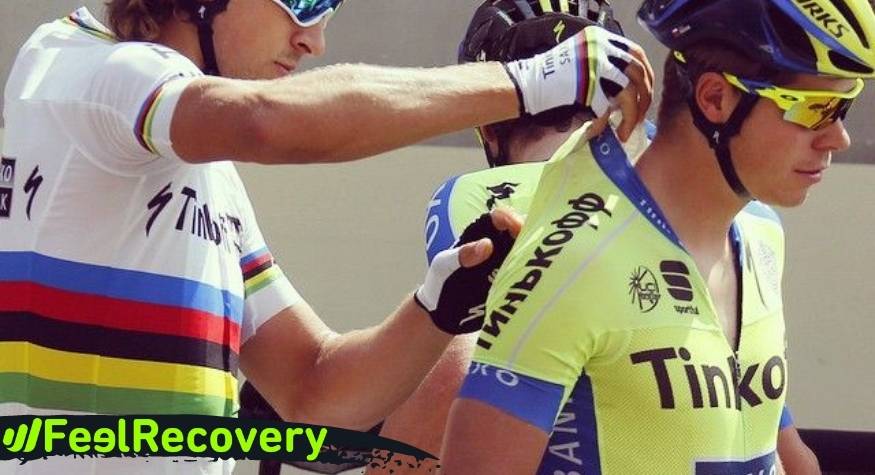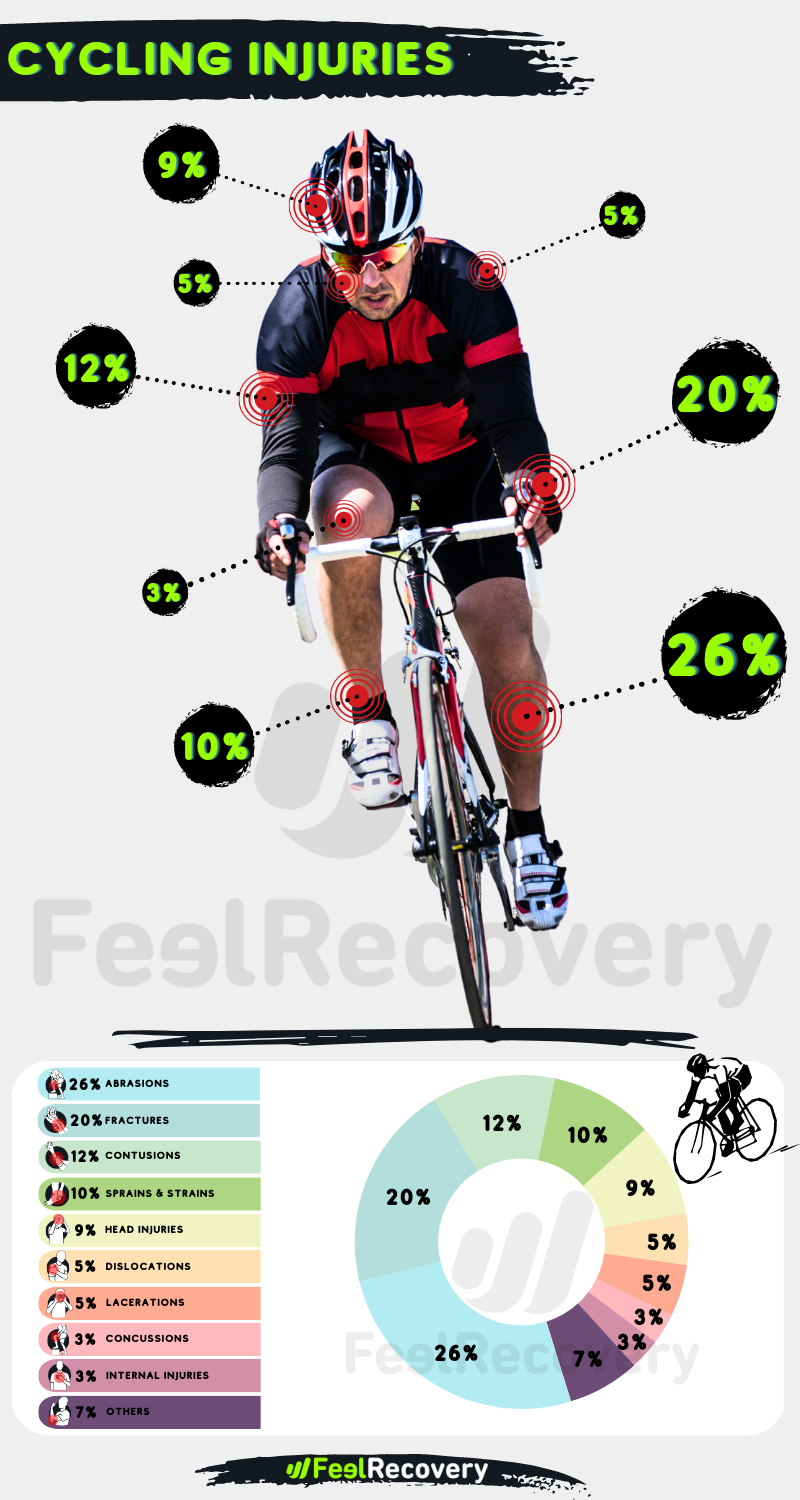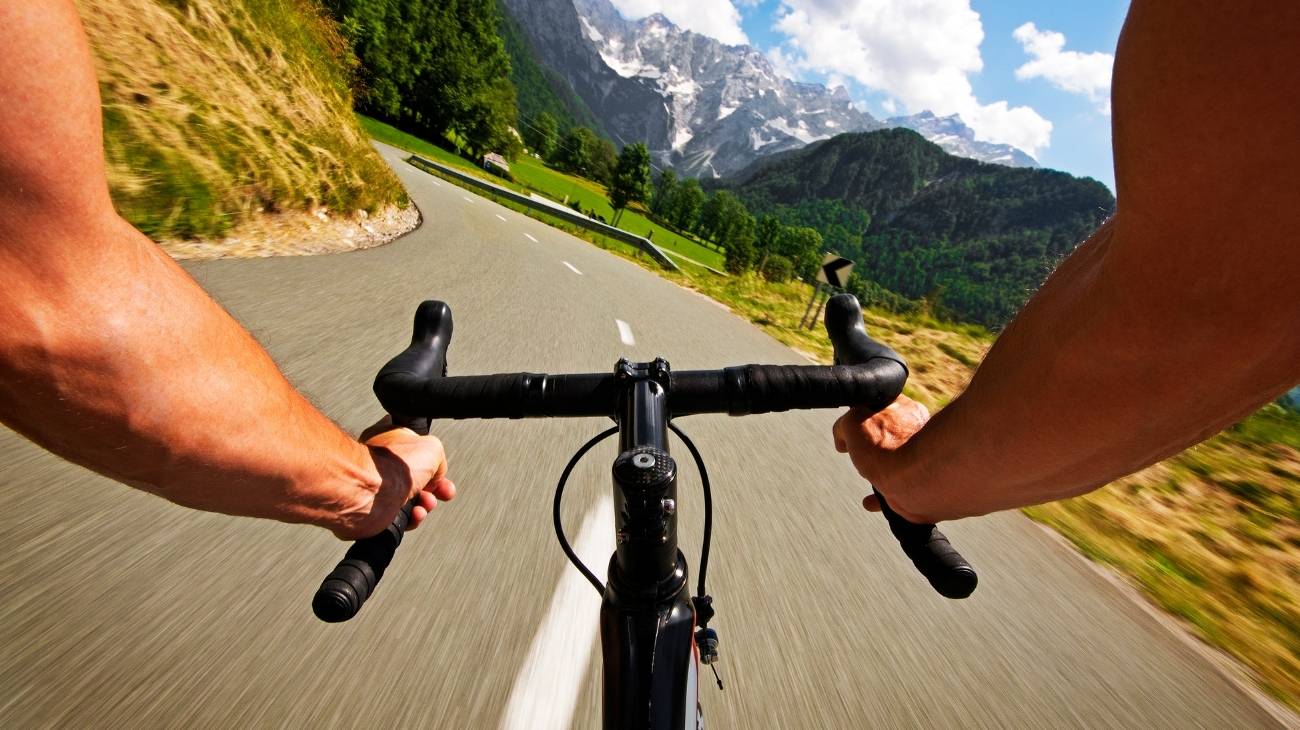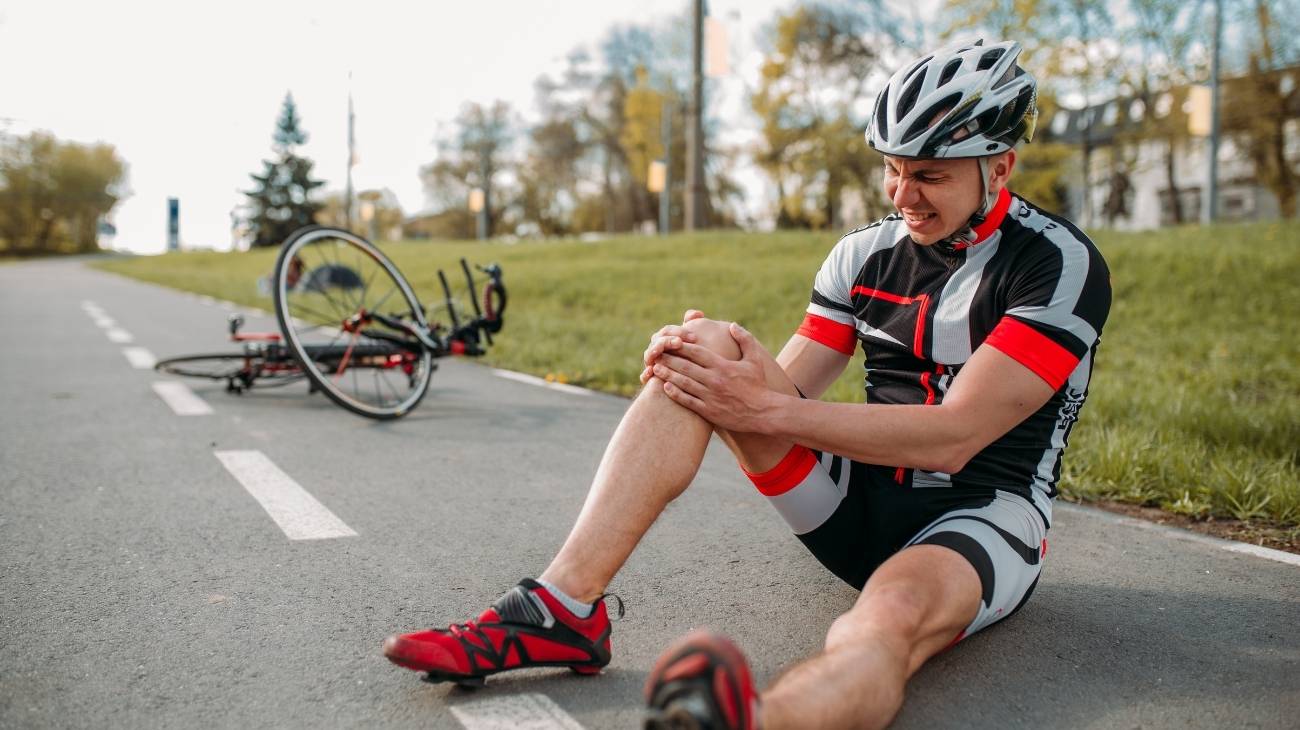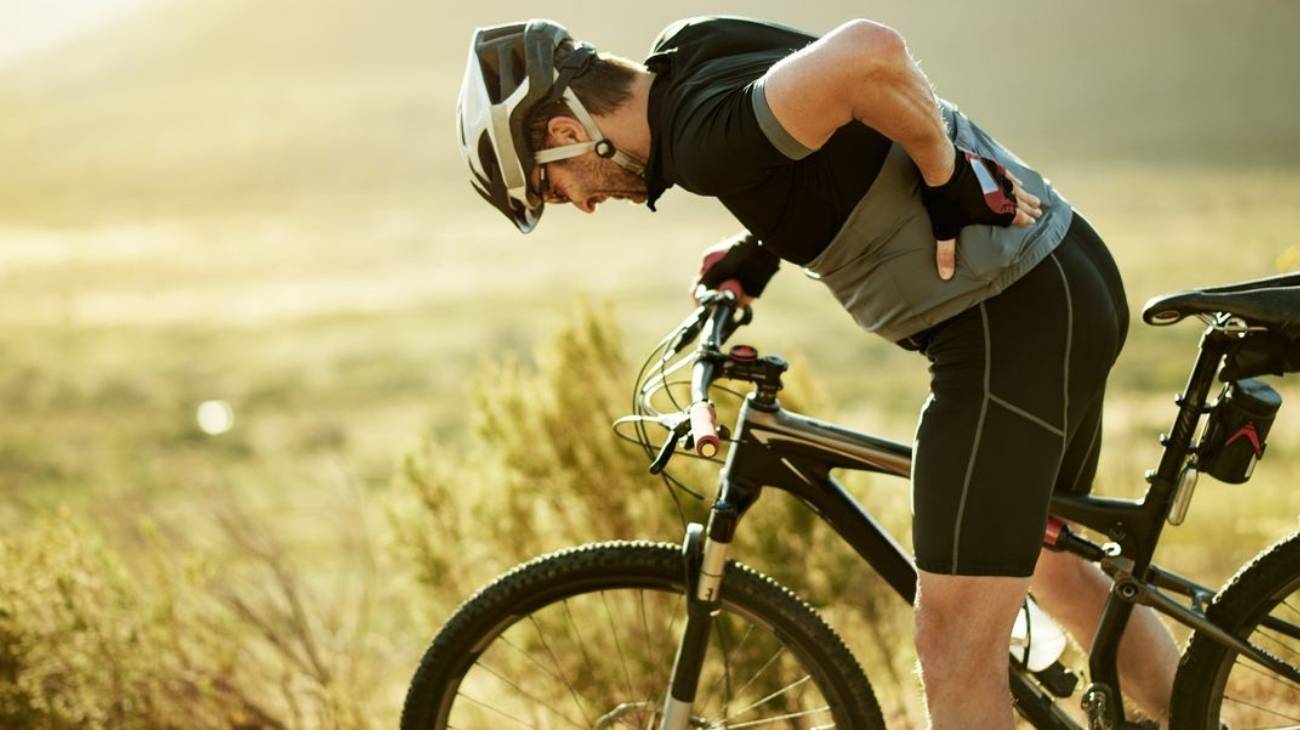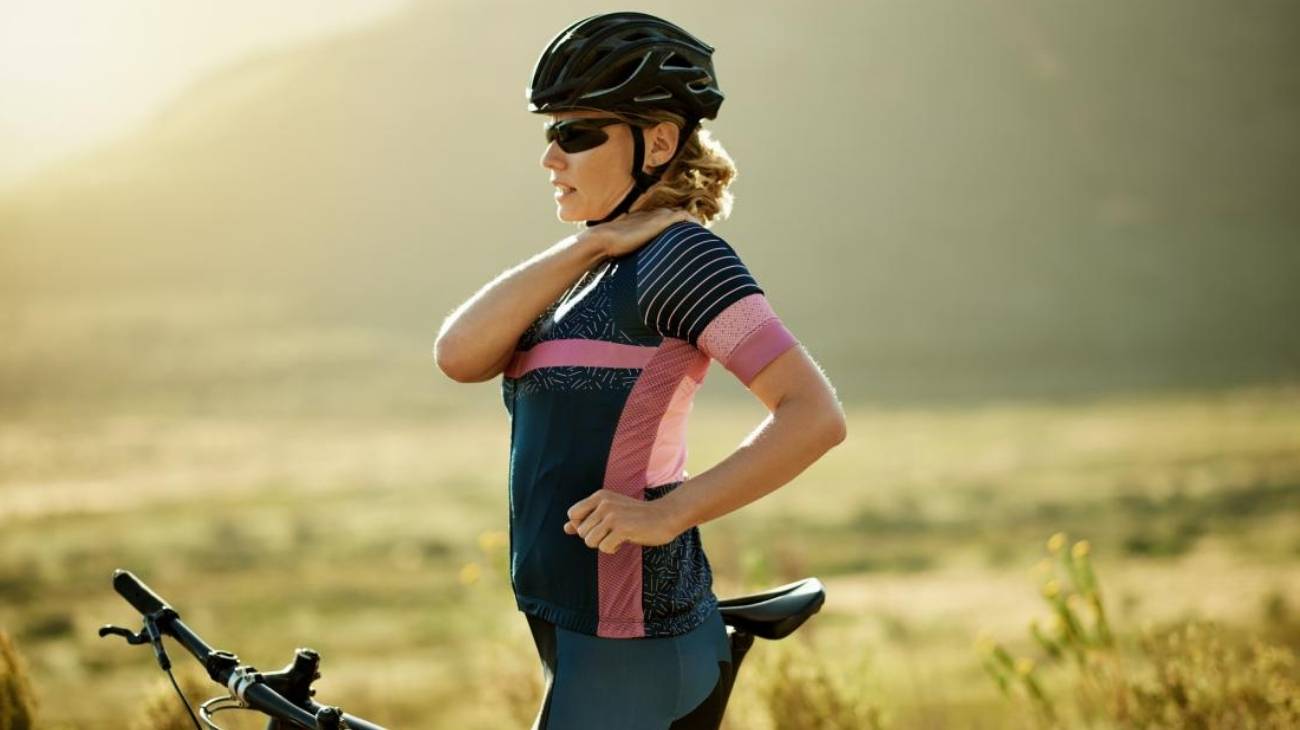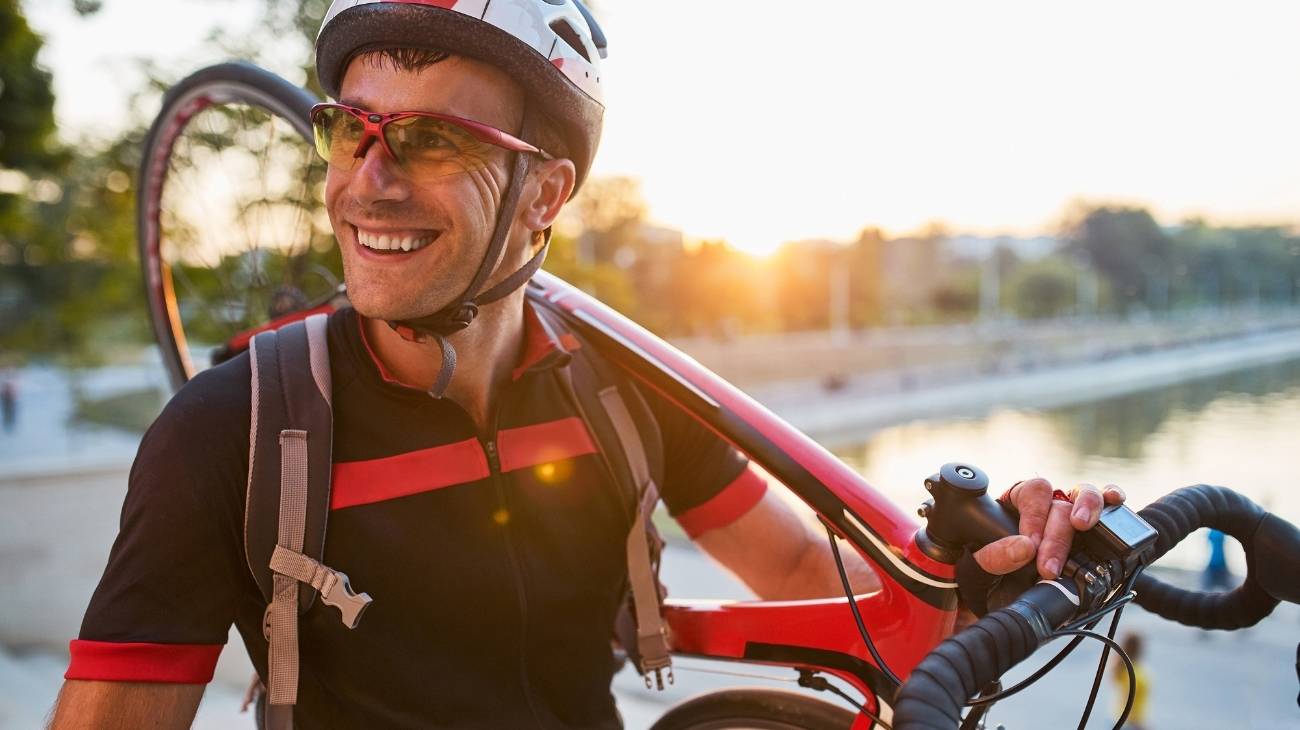Cycling is an extreme endurance discipline that demands excellent conditions in athletes and aches, pains and injuries are quite frequent. If you ever want to take part in the Tour de France, you must first prepare your body to make it less prone to injury.
In this article you will learn about the most common ailments in this discipline, as well as the most effective prevention methods to avoid injuries during training or competition.
What are the most common types of cycling injuries and pains?
In addition to the love of cycling, those who practice this sport share aches, pains and injuries that occur throughout their lives. Despite these risks, the passion that cyclists feel drives them to keep going and to prepare themselves to the maximum in order to be at their best for as long as possible.
Numbness
With the passing of hours on a bicycle, it is normal for the hands and feet to begin to "fall asleep". It is a numbness that affects performance in competition. It starts as a tingling sensation until the sensation in the limbs is almost completely lost.
The best thing to do in these cases is to better distribute the cyclist's weight. On the stretches where you don't feel so much stress, try varying your hand position; constantly open and close your fingers; or make brief finger-to-finger movements. Staying in one position is tiring over the course of training and long rides.
Buttock pain
There is no elegant way to refer to this discomfort. Almost all of a cyclist's weight is on the saddle, so it's not uncommon to have tingling and soreness in the buttocks. The muscles and bones gradually get used to the different positions the rider has the option to take on the bike.
So it's not worth worrying too much about this situation, although it will seem uncomfortable at first. If you notice that the pain in your buttocks is limiting you, you can buy a special lubricating cream that will protect you from chafing and prevent marks or burning of the skin. Not forgetting that sports massage can alleviate this problem in most cases.
Testicular discomfort
This is a situation that only men can understand, it is generated by the constant compression of the weight on the saddle. It is also a matter of habit and changing position from time to time. The compression occurs specifically on the pudendal nerve. Try leaning the saddle forward more, or look for groin protectors that can minimise the impact on the nerve.
Neck pain
Although cycling has very little serious impact on the body, the typical position of the cyclist for hours at a time is what causes the most pain. The neck area is under constant strain and this can lead to neck pain, especially if your body is not used to long cycling routes.
Perhaps the handlebar height is too high or you are stretched out too much in order to generate more power. Very aerodynamic or very upright positions for a long time take their toll on your neck. So make it a habit to do regular sports massages and use cold compresses on the area to reduce the impact of this ailment.
Knee discomfort
Let's understand that pedalling is a very repetitive movement and this leaves a significant wear and tear over the years of practice and competition. When the cartilage of the knee is very affected by wear and tear, this is when the pain appears. Recovery then costs a little more because we are talking about a slow and progressive process.
If your knee hurts frequently, try to change the type of pedal, it is a detail to take into account. Also, visit a physio regularly to rule out tendinitis or osteoarthritis, which is common in amateur cyclists who have been cycling for years.
Lower back pain
When the saddle is too high or set back, depending on the cyclist's build and biomechanics, low back pain is likely to appear over time. It is the second most common ailment among athletes in the sport. It is generated when there is an overload of weight and strain on one side of the lower back more than the other.
A bad body position also leads to muscle contractions and displaced discs that can touch the nerves in the spine and cause severe pain in the lower back.
Hot feet
This is a burning sensation in the feet, as opposed to numbness. In cycling it occurs if the shoes are too tight or if they are the wrong size for the person. It is a matter of excess pressure during the hours and hours that the cyclist has to be on the bike. It is recommended to get a better arch support, if you find that the pressure of the shoe is not what is affecting.
This is why a cyclist's footwear should be a subject to pay attention to, it is advisable to dedicate time and analyse what type and brand of shoe is the best to maintain sporting performance.
Tendonitis
The quadricipital tendon, patellar tendon and patellar flaps are most commonly affected. Tendonitis usually occurs when any of the above tendons are subjected to a lot of wear and tear or stress, which causes them to become irritated or inflamed and generate pain in the relevant joint.
As it is a matter of soft tissue wear and tear, it is best to rest for a period of time from activity while the tissue recovers, as continued strain can cause the condition to become chronic.
Perineal injuries
Friction causes injury to the perineum. Although rare, heavy perspiration running in areas of hair follicles causes folliculitis, cysts and subcutaneous fibrous nodules in the tissues. When damage is not detected early, it affects more vulnerable structures and causes prostatitis or urethritis.
Bicycles are fully adjustable and adjustable vehicles, so if you find a saddle that suits the way you ride, you should try to have several units of that model and prevent perineal discomfort from ruining a training session or competition.
Best products for cycling injury recovery
Bestseller
-
2 Calf Compression Sleeve (Black/Gray)
$24.95 -
2 Calf Compression Sleeve (Green/Navy)
$24.95 -
2 Calf Compression Sleeve (Pink/Bordeaux)
$24.95 -
2 Knee Compression Sleeve (Black/Gray)
$24.95 -
2 Knee Compression Sleeve (Green/Navy)
$24.95 -
2 Knee Compression Sleeve (Pink/Bordeaux)
$24.95 -
2 Thigh Compression Sleeve (Black/Gray)
$24.95 -
2 Thigh Compression Sleeve (Green/Navy)
$24.95 -
2 Thigh Compression Sleeve (Pink/Bordeaux)
$24.95 -
Microwaveable Heating Pad for Pain Relief (Hearts)
$24.95 -
Microwaveable Heating Pad for Pain Relief (Oxford)
$24.95 -
Microwaveable Heating Pad for Pain Relief (Sport)
$24.95 -
Sport Compression Socks (1 Pair) (Green/Navy)
$24.95
-
2 Patella Knee Strap (Black/Gray)
$14.95 -
2 Patella Knee Strap (Green/Navy)
$14.95 -
2 Patella Knee Strap (Pink/Bordeaux)
$14.95 -
Foot Massage Roller for Plantar Fasciitis (Black)
$24.95 -
Foot Massage Roller for Plantar Fasciitis (Green)
$24.95 -
Foot Massage Roller for Plantar Fasciitis (Pink)
$24.95 -
Ice Massage Roller Ball (Black)
$39.95 -
Ice Massage Roller Ball (Green)
$39.95 -
Ice Massage Roller Ball (Pink)
$39.95 -
Soft Density Foam Roller for Recovery (Black)
$39.95 -
Soft Density Foam Roller for Recovery (Green)
$39.95 -
Soft Density Foam Roller for Recovery (Pink)
$39.95 -
Sport Compression Socks (1 Pair) (Black/Gray)
$24.95 -
Sport Compression Socks (1 Pair) (Pink/Bordeaux)
$24.95
How to prevent injuries and pain when cycling?
As you already understand, most discomfort and injuries are due to your position, the shape of the saddle, the height of the handlebars and possible asymmetries in your body. Cycling alone does not cause serious injuries such as dislocations or sprains.
To avoid discomfort and injuries, we recommend these preventive measures to ensure that you have a long career in professional cycling:
Warm up
If you think that cycling will always be a cycle of simple, totally synchronised movements, you're wrong. As in any other professional sport, there must be a proper warm-up to allow the body to adapt to the demands of the day. Strides are a good way to start, with increasingly wider jumps to train the legs in a comprehensive way: muscles, tendons, joints and the plantar area.
For the arms and shoulders, simple push-ups are a good option and then move on to incline push-ups. This works to strengthen your arms and withstand the long hours of tension on the handlebars. Next you need to train your back strength, remember that neck and lower back problems are common. Find a moderate weight and place it on the back of your neck and shoulders, gently tilt your body forward and return to the original position.
A good warm-up will tell your body to prepare for the start of a more demanding sporting effort. And after training, there should be another process of organ regulation which we explain below.
Cooling down
What do we want in this phase? To assimilate the substances you have produced during training. If you didn't know, blood circulation is faster when you train and cooling down accelerates the recycling of nutrients.
At the end of your cycling route or training you can finish the session pedalling at less than 60% of your maximum intensity, it's like going for a walk. This should be done for 20 minutes. Even after a competition it is advisable to do this, to help the body recover much better from the effort made. What is never recommended is to finish training and sit down.
The right equipment
We will refer only to the clothing and accessories that the cyclist should have for a competition or training. They are all necessary equipment if the purpose is to increase performance and safety:
- Helmet: It fulfils two functions, the main one is to protect the athlete's brain in the event of a big fall, they are more resistant than you think. Its second purpose is to contribute to aerodynamics and reduce friction when the air is cut off. Fitting the helmet correctly is important, always watch and look at your chin. When tightening the straps, the helmet should be positioned occipitally.
- Goggles: The helmet has a slight protection against sun and heat, however goggles are great for this. They are useful to avoid sunstroke and wind affecting your visibility. Good goggles are lightweight and should fit snugly on your head without the need to use your hands to readjust them.
- Jersey: More than just a nice outfit, it is functional. It should fit close to the body to avoid friction in the wind, the less wind resistance the faster the rider goes. It can be long-sleeved, short-sleeved or with braces. When it is very hot, it is not advisable to wear a sweatshirt with long sleeves, for example. If you wear sweatshirts with zips, in sections of the race you can open it to cool down in very hot weather.
- Gloves: Their purpose is to reduce the friction of your hand on the handlebars and to prevent sweat from making you slip. They also protect you in case of a fall, as you will impulsively use your hands to avoid injury. Although leather is not breathable, it is very useful in the event of a fall and allows a better grip.
- Sleeves: There are areas where it is very cold in the morning and very hot as the sun rises. In view of this difference in the weather, the sleeves are perfect. You can go out in the morning with them on and take them off quickly without having to stop your training.
- Jacket: More than protecting you from the cold, this is an accessory against the rain. They are made of a synthetic material to prevent moisture from affecting your body, thus avoiding colds and complications such as bronchitis and pneumonia. And if you choose a professional jacket, it also serves as a windbreaker.
- Bib shorts: If you know that the saddle hurts you, depending on your posture, this accessory is very important. It protects your perineal area. The garment should fit snugly without generating discomfort, too tight affects the blood circulation in the body.
- Cycling shoes: The model will depend on whether your type of cycling is mountain, city or closed track. They are different because the pedal attachments are also different. A good recommendation is that the shoes should allow you to move your toes freely inside them.
- Socks: They allow no friction between your skin and the shoes, and they should be breathable. The most important thing is that your feet stay dry.
- Boot covers: They are used when we have verified that they increase performance, they do it by covering the elements of the shoes and they allow to lower the friction with the wind.
Nutrition and hydration
Male and female cyclists make different use of energy substrates, so nutrition varies. Women have to ingest more fat in their diets as a source of energy, so carbohydrate intake during recovery is lower.
The body requires less protein in women. In both cases, the daily diet should be based on the intake of fruit, vegetables and greens for the micronutrients and antioxidants they provide to the body. Both in competition and in training, the last meal should be eaten three hours before the start of the sporting event.
What about hydration? It is not recommended to drink large quantities of liquid, but rather to drink small amounts several times during the day. Energy drinks should be taken up to half an hour before a competition and reinforced during the run with small sips.
For long training rides or races, it is recommended to drink water every 30 minutes and for rides longer than 3 or 4 hours it is recommended to eat some solid food, this will vary according to the cyclist's experience and fitness.
Fitness
On average, the ideal weight of a professional cyclist should not exceed 70 kilograms. However, the ideal weight is relative because it will also depend on your height, bone formation and natural build.
What should be taken into account? That he should not be too thin so that he has enough strength in his legs and that he is not too heavy so that this is not a burden on his power. There must be a balance and the athlete must feel excellent with his build. In addition to cycling, athletes should frequent other sports that improve their heart rate and increase lung power.
In the past, in endurance sports, coaches and fitness experts did not recommend weight work, but recent studies have shown that even endurance cyclists should perform periods of strength training during the season to avoid injury and improve performance.
Recovery therapy
Rather than a corrective issue, in the cyclist it will always be a preventative one. No therapy should be ruled out to make a cyclist perform as well as possible in his or her career.
- Sports massage: These massages cleanse the body of toxins that often result in injury and discomfort. They loosen nested points, speed up recovery and relax the whole body.
- Use of hot and cold therapies: When changing the intensity of training, the body is likely to respond negatively at the first change. Muscle, joint and ligament discomfort may occur. Cold increases surface vasoconstriction and lowers inflammation, thus relieving pain. At the same time, heat generates superficial vasodilatation and increases blood circulation in the body. This removes waste and pain-causing substances.
- Use of compression garments: Compression stockings are the most commonly used. They promote venous return, i.e. they make the blood flow normally and increase oxygen to the muscles. Both in training and in competitions, they help to have a better result.
- Use of acupressure therapy: The part of the body that most often requires acupressure therapy is the feet. Cyclists use a special mat that helps to reduce muscle stress, but it is always better if a specialist is in charge of applying the therapy. Acupressure is similar to acupuncture, the difference is that no needles are used to drain trapped energies in a single area of the body.
- Use of thermotherapy and cryotherapy: Whether through compresses, baths or gel application, these therapies have specific effects depending on the discomfort or ailment. For the muscular preparation of the athlete, thermotherapy is better, as it prevents future injuries due to the stress felt by the athlete. If it is gel, it should be applied one hour before the competition because it lowers tensions, reduces strains and fibrillar breaks. And to speed up muscle recovery, the best thing is cold. Strains, sprains, injuries and haemorrhages leave a strong pain that ice helps to alleviate. In both cases, the goals and purposes are medium and long term, which is the difference with the classic hot and cold therapies.
How to apply the RICE therapy to treat first aid injuries in cycling?
These are initial recommendations to apply to an injury. They are methods of approach that can be applied by you, although it is better if a sports doctor does it.
- Protection: The arm or leg is immobilised to benefit and protect the joints, ligaments and tendons. The last thing we want is for new movements to further affect the initial injury.
- Rest: The length of this step is determined by the type and severity of the injury. The regeneration of the damaged cells is desired. When rest lasts longer than desired, normal activity should be resumed gradually if the sports doctor recommends it.
- Ice: Cold is an excellent ally to relieve pain and reduce inflammation. Rather than placing ice cubes on the skin, you should understand that there is a limit of 20 minutes in its use and that the positive effect will appear according to the severity of the injury.
- Compression: The aim is to mechanically lower the interstitial space and limit the formation of oedema. We also want to generate a vasoconstriction to lower the blood flow in the lesion, especially if there is internal bleeding.
- Elevation: Quite useful for the lower extremities, and recommended in the first 48 hours after injury, and even more important in the first few minutes. Lift the affected area above the level of the heart and you will notice how gravity reduces the swelling.
When should we see a specialist for the treatment of cycling injuries?
In the case of a cyclist it is not necessary to go to the doctor for dislocations, sprains or fractures, it is obvious that in these cases you should seek help from a health professional. It is only when the pain or discomfort is severe or permanent that professional help is needed.
What you don't correct in training can be fatal in competition. What you should never do is go to a competition if you know there is an injury that has not been checked or has not had sufficient time for recovery.
As we have already mentioned, cycling is a sport of endurance and repetitive movements, so any discomfort, no matter how small, can turn into a more serious injury due to the continuous pedalling movements.
References
- Cohen, G. C. (1993). Cycling injuries. Canadian Family Physician, 39, 628. https://www.ncbi.nlm.nih.gov/pmc/articles/PMC2379777/
- Wanich, T., Hodgkins, C., Columbier, J. A., Muraski, E., & Kennedy, J. G. (2007). Cycling injuries of the lower extremity. JAAOS-Journal of the American Academy of Orthopaedic Surgeons, 15(12), 748-756. https://journals.lww.com/jaaos/Abstract/2007/12000/Cycling_Injuries_of_the_Lower_Extremity.8.aspx
- Mellion, M. B. (1991). Common cycling injuries: management and prevention. Sports Medicine, 11, 52-70. https://link.springer.com/article/10.2165/00007256-199111010-00004
- Mulvaney, C. A., Smith, S., Watson, M. C., Parkin, J., Coupland, C., Miller, P., ... & McClintock, H. (2015). Cycling infrastructure for reducing cycling injuries in cyclists. Cochrane database of systematic reviews, (12). https://www.cochranelibrary.com/cdsr/doi/10.1002/14651858.CD010415.pub2/full
- Sanner, W. H., & O'Halloran, W. D. (2000). The biomechanics, etiology, and treatment of cycling injuries. Journal of the American Podiatric Medical Association, 90(7), 354-376. https://japmaonline.org/view/journals/apms/90/7/87507315-90-7-354.xml
- Kotler, D. H., Babu, A. N., & Robidoux, G. (2016). Prevention, evaluation, and rehabilitation of cycling-related injury. Current sports medicine reports, 15(3), 199-206. https://journals.lww.com/acsm-csmr/Fulltext/2016/05000/Prevention,_Evaluation,_and_Rehabilitation_of.18.aspx
- Aldred, R. (2016). Cycling near misses: Their frequency, impact, and prevention. Transportation Research Part A: Policy and Practice, 90, 69-83. https://www.sciencedirect.com/science/article/pii/S0965856416303639
- Kronisch, R. L. (1998). Mountain biking injuries: fitting treatment to the causes. The Physician and sportsmedicine, 26(3), 64-70. https://www.tandfonline.com/doi/abs/10.1080/00913847.1998.11440349
- Hollingworth, M. A., Harper, A. J., & Hamer, M. (2015). Risk factors for cycling accident related injury: The UK Cycling for Health Survey. Journal of Transport & Health, 2(2), 189-194. https://www.sciencedirect.com/science/article/abs/pii/S221414051500002X
- Embree, T. E., Romanow, N. T., Djerboua, M. S., Morgunov, N. J., Bourdeaux, J. J., & Hagel, B. E. (2016). Risk factors for bicycling injuries in children and adolescents: a systematic review. Pediatrics, 138(5). https://publications.aap.org/pediatrics/article-abstract/138/5/e20160282/60425/Risk-Factors-for-Bicycling-Injuries-in-Children



